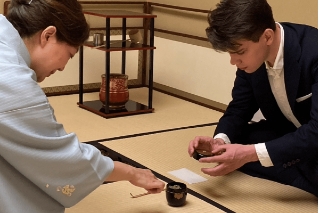Historical Background of the Japanese Tea Ceremony
Origins and Evolution
The Japanese tea ceremony, known as Chanoyu or Chado, is a deeply rooted tradition that has evolved over centuries.
It is intertwined with the cultural and spiritual fabric of Japanese society. The origins of the tea ceremony can be traced back to the 12th century, during the Kamakura period when Zen Buddhism was introduced to Japan.
Zen monks, seeking a path to enlightenment, incorporated tea drinking into their daily rituals, emphasizing mindfulness and simplicity.
This practice gradually spread beyond monastic circles, becoming a cherished custom among the aristocracy and eventually permeating all levels of Japanese society.

Key Figures in History
Several key figures played pivotal roles in shaping the tea ceremony into the refined art form it is today.
One of the most influential was Murata Shuko (1502-1575), a Zen monk who established the fundamental principles of Chanoyu, emphasizing the philosophy of Cha-Zen-Ichimi, meaning tea and Zen share the same spirit.
His teachings laid the groundwork for the development of distinct tea schools that emerged in subsequent centuries.

Cultural Significance
The Japanese tea ceremony transcends mere beverage consumption; it is a profound expression of Japanese aesthetics, philosophy, and social etiquette.
It embodies the ideals of wabi-sabi, which appreciates the beauty of imperfection and transience, and the concept of Mono no aware, a deep sensitivity to the fleeting nature of life.
The ceremony fosters a sense of mindfulness, tranquility, and connection with nature, offering a sanctuary from the hustle and bustle of everyday life.

Buke-cha: Tea Ceremony for Samurai
Origins and Purpose
The Buke-cha tea ceremony, developed during the Edo period (1603-1868), emerged as a distinct form of Chanoyu practiced by the samurai class.
It was influenced by the ideals of Bushido, the code of the samurai, emphasizing discipline, loyalty, and self-control.
Buke-cha ceremonies were often held in the context of military gatherings, serving as a means of fostering camaraderie, strengthening bonds, and demonstrating respect among warriors.

Women’s Practice of Tea
Although many people think of the tea ceremony as something for women to enjoy, in fact, it can be traced back historically as a male-centered culture. It was mainly after the Meiji period in the late 19th century, especially after World War II, that the door was opened to women.
It also seems that women of the upper classes enjoyed the tea ceremony during the Edo period, but unfortunately, there are not enough data available. As a family member of Buke, the samurai class, Hoshina’s interest also focuse on the research of Buke-cha for women.

Legacy and Continuation
The Buke-cha tradition has endured through the centuries, albeit with some adaptations.
While the strict military context of the Edo period has faded, the spirit of Buke-cha continues to resonate in modern tea ceremonies.
Its emphasis on discipline, respect, and the pursuit of excellence remains relevant, inspiring practitioners to cultivate a sense of mindfulness and self-awareness.

Modern Day Schools
Prominent Schools Today
Today, the Japanese tea ceremony continues to thrive, with numerous schools and practitioners carrying on the tradition.
The San-Senke schools remain the most prominent, with their branches extending throughout Japan and internationally.
Other notable schools include the Enshū-ryū, founded by the renowned tea master Kobori Enshū, and the Furuta Oribe-ryū, known for its rustic and eclectic style.

Global Influence
The Japanese tea ceremony has had a profound influence on tea practices and cultural exchanges worldwide.
Its emphasis on mindfulness, simplicity, and the appreciation of beauty has resonated with people from diverse backgrounds.
Tea ceremonies have become a popular form of cultural diplomacy, fostering understanding and appreciation between Japan and other nations.

Legacy and Continuation
The Buke-cha tradition has endured through the centuries, albeit with some adaptations.
While the strict military context of the Edo period has faded, the spirit of Buke-cha continues to resonate in modern tea ceremonies.
Its emphasis on discipline, respect, and the pursuit of excellence remains relevant, inspiring practitioners to cultivate a sense of mindfulness and self-awareness.

Conclusion and Reflection
Summary of the Key Points
The Japanese tea ceremony is a multifaceted tradition that embodies the essence of Japanese culture, encompassing aesthetics, philosophy, and social etiquette.
Its origins can be traced back to Zen Buddhism, and its evolution has been shaped by influential figures like Murata Shukō and Sen no Rikyū.
The San-Senke schools, Urasenke, Omotesenke, and Mushanokōjisenke, represent the major branches of the tea ceremony, each with its unique practices and philosophies.
The Buke-cha tea ceremony, developed for the samurai class, reflects the ideals of Bushido and has left a lasting legacy on the tradition.
Today, the tea ceremony continues to thrive, with prominent schools and practitioners carrying on the tradition both in Japan and internationally.
The Future of the Tea Ceremony
The future of the Japanese tea ceremony is bright, as it continues to evolve and adapt to the changing times.
The tradition’s emphasis on mindfulness, simplicity, and the appreciation of beauty remains timeless, resonating with people from all walks of life.
As the world becomes increasingly interconnected, the tea ceremony offers a powerful platform for cultural exchange and understanding.
It is a tradition that transcends borders and generations, inviting us to pause, reflect, and savor the simple pleasures of life.

Personal Reflections
Having the opportunity to experience and study the Japanese tea ceremony has been a profound and enriching journey.
It has taught me the importance of mindfulness, respect, and the appreciation of beauty in the everyday.
The ceremony’s emphasis on simplicity and harmony has inspired me to cultivate a more mindful and balanced approach to life.
The tea ceremony is not merely a ritual; it is a way of life, a philosophy that invites us to connect with ourselves, with others, and with the world around us.


